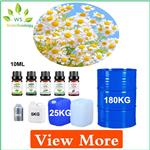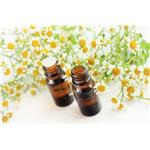The essential oil is obtained by steam distillation of flowers and stalks with variable yields ranging from 0.3 to more
than 1%, depending on the area of production. It has a characteristic intensely sweet, herbaceous coumarin-like odor with a fresh
undernote.
Blue chamomile oil (German chamomile oil) is obtained by steam distillation
of the flowers and stalks of Chamomilla recutita (L.) Rauschert (Matricaria
recutita. L., Matricaria chamomilla L., Asteraceae). For oil production,
chamomile is grown mainly in Eastern Europe (Hungary, Bulgaria) and
Egypt. Few tons are produced annually. It is a deep blue or bluish-green liquid that turns green and, finally, brown when exposed to light and
air. The oil has a strong, characteristic odor and a bitter, aromatic taste.
Chamazulene is responsible for its blue color. Chamazulene and
(?)-α-bisabolol contribute to the anti-inflammatory properties of blue chamomile oil.
d2020 0.910–0.970/0.910–0.950; chamazulene (2–5%)/(5–22%); bisabolol
(1–10%)/(15–40%) (Egyptian/Hungarian oils). Blue chamomile oil is
used preferentially in pharmaceutical preparations, but also in small quantities
in flavoring of alcoholic beverages.
It is a deep-blue or bluish-green liquid. When exposed to light or air, the blue color changes
to green and finally to brown. Upon cooling, the oil may become viscous. It is soluble in most fixed oils and propylene glycols. It is
insoluble in glycerin and mineral oils.
Found in the plant Matricaria chamomilla L. (Fam. Compositae).
Chamomile Absolute is a flavor and fragrance agent. Chamomile Absolute exhibits similar biological functions like Apigenin (A726500)
By steam distillation of the flowers and stalks of Matricaria chamomilla L.
Extractives and their physically modified derivatives. Matricaria chamomilla, Compositae.
Essential oil composition
A constituent of chamomile oil German is chamazulene
Low toxicity by
ingestion and skin contact. A mild allergen.
A skin irritant. See also ESTERS. When
heated to decomposition it emits acrid and
irritating fumes.


